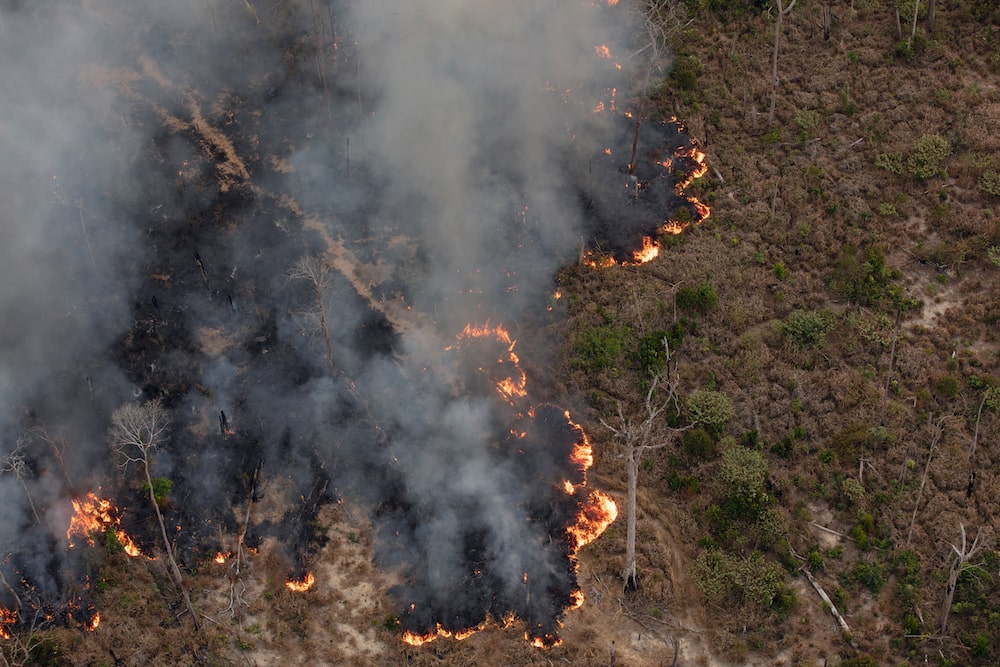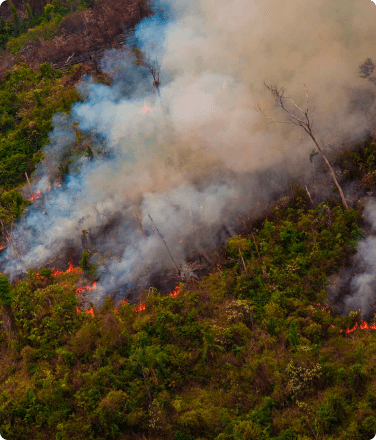A devastating image of fires ravaging Brazil’s Amazon, July 2024.
IMAGE CREDIT: © Marizilda Cruppe / Greenpeace
- The Amazon is experiencing record-breaking fires in 2024, exacerbated by climate change and El Niño.
- In the first seven months of 2024, the Brazilian Amazon recorded the highest number of fires in the last 20 years.
- Although deforestation in the region decreased by 50% in 2023 compared to 2022, burned areas increased by 36%.
In a troubling trend, the Brazilian Amazon registered a 76% increase in fire hotspots during the same seven-month period (January – July) from 2023 to 2024. According to Brazil’s National Institute for Space Research (INPE), the Brazilian Amazon registered 24,923 fire hotspots from January through July, the highest number for this period since 2005. In the month of July 2024 alone, 11,434 fire hotspots were recorded, an increase of 98% compared to the same month last year (which recorded 5,772 fire hotspots). The highest number of fires in the month was recorded on July 30, with 1,348 records in a single day.
Bolivia also experienced a record number of fires in the first seven months of the year. According to data from INPE, which monitors fires in all of South America, the country registered roughly 17,700 fire points from January through July, the most ever seen in that period. Venezuela, Guyana, and Suriname also saw the most fires in the first seven months of the year.

“Historically, a high rate of deforestation and fires is expected in the Amazon between July and October, a period known as the ‘Amazonian summer.'”
Several factors have contributed to the surge in fires in the Amazon. The region is experiencing drier conditions, a phenomenon closely linked to climate change and intensified by El Niño. In fact, 2023 was the hottest year ever recorded, and June 2024 marked 13 consecutive months of record temperatures, increasing the forest’s vulnerability to fires. The region also experienced a historic drought in 2023, which caused flames to spread through native vegetation. Low water levels in the region’s rivers made it difficult to combat the fires, leaving Indigenous and riverside villages inaccessible.
“Historically, a high rate of deforestation and fires is expected in the Amazon between July and October, a period known as the ‘Amazonian summer.’ This period is characterized by decreased rainfall and relative humidity, as well as increased temperatures, which leave the vegetation drier and more susceptible to fire. Considering that we still have three more months of the Amazonian summer, the fire and drought situation is extremely concerning in the Amazon,” explains Christine Halvorson, Program Director of Rainforest Foundation US (RFUS).
Deforestation Reduction vs. Increase in Burned Areas
According to INPE, deforestation rates in the Brazilian Amazon decreased by 50% in 2023 compared to 2022. Though lower deforestation rates typically mean fewer fires, the areas burned increased by 36%, with approximately 26.6 million acres destroyed by fires in 2023 compared to 19.5 million acres in 2022.
The Brazilian government focused fire prevention efforts on 71 priority municipalities, which reduced fires in pasture and agricultural areas. Conversely, native forests in northern regions were severely affected by increased fires set by criminals on Indigenous peoples’ lands, conservation units, public forests, and other types of public lands.
The Need for Coordinated Action

“We know that reducing deforestation and supporting Indigenous and local communities’ fire brigades is effective in both preventing and mitigating the impact of fires.”
“We know that reducing deforestation and supporting Indigenous and local communities’ fire brigades is effective in both preventing and mitigating the impact of fires. However, with the Amazon in an extended drought and quickly approaching a tipping point, the scale of these fires presents a very new type of threat to the region. Forest protection and traditional fire management practices will need to be reinforced with more systematic state measures, including accountability, emergency response planning, and aerial fire suppression,” argues Cameron Ellis, Field Science Director of RFUS.
In fact, deforestation linked to agriculture and cattle ranching is a key factor in the spread of fires. Those involved in these economic sectors will often clear large areas then burn the dry vegetation to make way for planting or pasture. However, fires frequently spread out of control during the dry season, escaping into the forest and destroying much larger areas. For many criminal actors, this “accidental” wildfire is a deliberate method for land grabbing in protected areas or Indigenous territories. Government agencies and institutions must identify the cause of the fire and pursue legal action against any criminal activity. This is a crucial part of any coordinated response for lasting forest protection.
“The mixture of climate change with El Niño contributes to highly flammable soil conditions, but the Amazon is not a biome that naturally burns. The response to fires in the Amazon should be a command-and-control strategy, with joint operations and rigorous penalties,” adds Halvorson.
Immediate actions are needed to protect this vital biome and its communities. And raising awareness about the severity of the situation and the need for immediate action to protect the Amazon is vital to ensuring a more sustainable future for the Amazon rainforest and its inhabitants.








